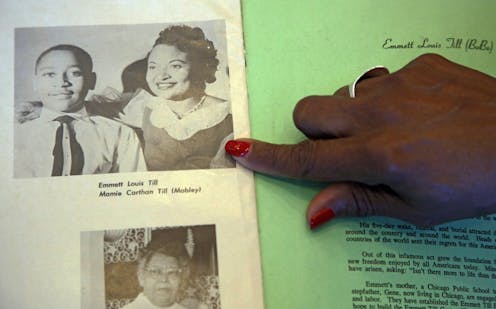Emmett Till's life matters
- Written by Davis W. Houck, Professor, Florida State University

The U.S. federal government is again investigating the case of Emmett Till’s murder, the Department of Justice has announced[1], bringing optimism that some measure of justice might ultimately prevail.
Nearly 63 years after he was kidnapped, brutally tortured, murdered, and then dumped into the Tallahatchie River in Mississippi, the Till case continues to resonate with audiences around the world because the case represents an egregious case of justice denied.
As a historian of the Mississippi civil rights movements[2], I quickly learned that most Mississippi civil rights history leads back to the widespread outrage over the Till case in the summer of 1955.
Emmett in Money, Mississippi
Fourteen-year-old Emmett arrived in Mississippi on Aug. 20, 1955, from Chicago to visit his mother’s family, who sharecropped cotton in the tiny Delta community of Money.
On the evening of Aug. 24, Emmett and several cousins and neighbors drove the 2.8 miles into Money to buy candy at the Bryant Grocery and Meat Market.
Emmett entered the store alone. He bought 2 cents worth of bubble gum and left. At the door Emmett let out a loud, two-note wolf whistle directed at white 21-year-old Carolyn Bryant. His cousins were terrified: Emmett had just hit the trip wire of Southern racial fears by flirting with a white woman.
Early on Aug. 28, several men – white and black – took Emmett from his family’s house. Emmett’s badly decomposed and battered body was discovered three days later in the Tallahatchie River. Emmett’s uncle could only identify Emmett by a ring he was wearing that once belonged to Emmett’s father, Louis Till.
Two white men, Roy Bryant and J. W. Milam, were quickly arrested and later charged with murder. During a five-day trial in September, the two men were found not guilty after a 67-minute deliberation by an all-white, all-male jury.
Several years later, members of the jury confessed to a Florida State University graduate student, Hugh Stephen Whitaker[3], that they knew the men were guilty but simply wouldn’t convict a white man of crimes against a black child.
In 1956, Milam and Bryant sold their[4] “shocking true story” of what happened to Till for US$3,150 to Look Magazine. For nearly 50 years, celebrity journalist William Bradford Huie’s “confession” story in Look functioned as the final word on the case.
Till then and now
Southern newspapers wanted immediately to forget the Till story, ashamed of the backlash caused by Milam and Bryant’s “confession.” Many Northern and Western newspapers editorialized on the case long after its conclusion. America’s black press never quit writing about the case; it was their work, after all, helping to track down black eyewitnesses in September 1955 that helped us understand the truth of what actually happened to Emmett Till on Aug. 28, 1955.
Thanks to investigative work[5] by documentary filmmaker Keith Beauchamp and others, the public has since learned that Milam and Bryant were part of a much larger lynching party, none of whom were ever punished.
Today, all of the people directly involved in Till’s murder are dead – save for one: Carolyn Bryant Donham. Eighty-four years old and living with family in Raleigh, North Carolina, FBI investigators and federal prosecutors have had their eyes on Bryant-Donham for several years. Whether she was a willing participant in Till’s kidnap and murder or, as her family claims, she had tried to protect Emmett from harm, she remains the focus of the announcement from the Department of Justice.
The Till case continues to resonate, especially for a nation that still experiences the all-too-frequent and seemingly unprovoked deaths of young black men. Whether it’s the Bay County, Florida, murder of Martin Lee Anderson[6] or the Sanford, Florida, killing of Trayvon Martin, Emmett Till’s murder powerfully represents myriad acts of white-on-black killing that have gone unpunished. The Black Lives Matter movement might have received a jolt from the shooting death of Michael Brown, but long before Ferguson there was Money, Emmett and a whistle.
References
- ^ has announced (www.nytimes.com)
- ^ Mississippi civil rights movements (books.google.com)
- ^ Hugh Stephen Whitaker (fsu.digital.flvc.org)
- ^ sold their (www.pbs.org)
- ^ investigative work (www.youtube.com)
- ^ Martin Lee Anderson (www.nytimes.com)
Authors: Davis W. Houck, Professor, Florida State University
Read more http://theconversation.com/emmett-tills-life-matters-99923

